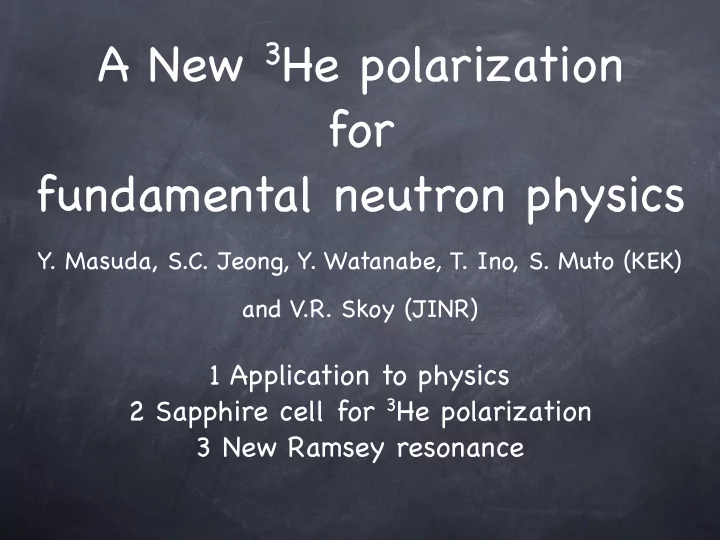

A New 3 He polarization for fundamental neutron physics Y. Masuda, S.C. Jeong, Y. Watanabe, T. Ino, S. Muto (KEK) and V.R. Skoy (JINR) 1 Application to physics 2 Sapphire cell for 3 He polarization 3 New Ramsey resonance
Fundamental Physics tests for fundamental symmetries: neutron β decay, T violation, PV spin rotation, np->d γ asymmetry, and so on. precision experiments high nuclear polarization with high precision high counting statistics low background
β decay asymmetry A β counter θ 3 He spin n counter n spin W( θ ) ∝ 1 + P n · (v/c) · A · cos θ δ P n < 10 -3
A is crucial for G A and G V G V = V ud G F V ud from 0 + → 0 + nuclear β decay contradicts the CKM unitarity Precision asymmetry with 10 -3 is required (for ~ 100 days of beam time at J-PARC)
T violating n transmission D s · ( k × I ) : T-odd x La spin I n spin s n momentum n momentum n k k z y 3 He spin n spin s La spin I time reversal n spin flip
Baryon asymmetry D s · ( k × I ) is obtained from double asymmetry upon n spin flip and transmission reversal C s · k (P-odd) is already measured λ = T-odd/P-odd = 10 -4 (for ~ 1 year) → n EDM of 10 -26 ~ 10 -27 e · cm Gudkov, Posperov Supersymmetry and baryon asymmetry → n EDM of 10 -26 ~ 10 -27 e · cm
A new Ramsey resonance n spin manipulation for the T violation experiment, β decay, and neutron spectrometer
Why 3 He polarization ? Polarized 3 He is ideal slow neutron polarizer 3 He(n, p)t bound state resonance J = 1/2 (n spin) + 1/2 ( 3 He spin) = 1 (parallel) σ ± = σ 0 [1- (±P He )], σ 0 ∝ 1/v, v: neutron velocity σ 0 = 5333 b at v = 2200 m/s σ s = 3.1 b
Spin exchange optical pumping Compared with meta stability exchange optical pumping high pressure polarized 3 He gas compact continuous pumping for experiment
Sapphire cell Appl.Phys.Lett. 87 (2005)053506 sapphire is impervious to hot alkali vapor very clean flat surface to the neutron beam, strong for high pressure very low neutron cross section birefringence
Phase shift difference at birefringent window n o Ψ f Ψ i n e l θ = 2 π (n o - n e ) l/ λ is controlled by l P pho = cos 2 ( θ /2) - sin 2 ( θ /2) Ψ i = R (right handed state) Ψ f = cos( θ /2)exp[i( θ /2)] × R + sin( θ /2)exp[i( θ /2- π /2)] × L
Expected polarization P pho = 87% at θ = 23 o 3 He spin relaxation time 1/ γ = 24 h if 3 He-Rb spin exchange rate γ se = 1/5 h -1 at 195 o C (Baranga 1998)) γ se /( γ se + γ ) = 83% P He = P Rb γ se /( γ se + γ ) = 72% assuming P Rb = P pho
3 He polarization is measured by n transmission T = A exp(- σ 0 Nd)cosh(P He σ 0 Nd) T 0 = A exp(- σ 0 Nd) : transmission at P He = 0 A: transmission at N = 0 ( σ 0 Nd = 0) T/T 0 = cosh(P He σ 0 Nd) and T 0 /A = exp(- σ 0 Nd) → P He P n = tanh(P He σ 0 Nd) → P n = √ 1-(T 0 /T) 2
Experimental set-up
Result Δ P n = 10 -3 is possible
Comparison with expectation P He = 63±1% at a pressure of 3.1 atm P He = P Rb γ se /( γ se + γ ) = 72%, Low P Rb . The frequency narrowed laser of 11 W is not enough. Rb spin destruction rate is higher than expected because of laser heating.
A new Ramsey resonance for pulsed neutron spin manipulation θ = ( ω - ω 0 ) t γ H 1 t r = π /2 x x + Δ H 0 π /2 π /2 3 He cos θ z n spin y H 0 ( ω 0 = γ H 0 ) rotating field H 1 · x · cos ω t r + H 1 · y · sin ω t r ω = ω 0 RF coils inserted into the solenoid
Results θ = 0, π flipper for the T violation and β decay 0.5 0.4 0.3 0.2 RF on/off - 1 0.1 0.0 -0.1 -0.2 theoretical curve -0.3 3 He polarization cross section -0.4 -0.5 0.1 1 Neutron energy (eV)
Timing of RF pulse was changed 0.5 0.4 0.3 0.2 RF on/off - 1 0.1 0.0 -0.1 -0.2 -0.3 -0.4 -0.5 0.1 1 Neutron energy (eV)
RF phase was modulate as a function of n TOF for T-violation and n spectrometer 0.5 0.4 0.3 0.2 RF on/off - 1 0.1 0.0 -0.1 -0.2 -0.3 -0.4 -0.5 0.1 1 Neutron energy (eV)
Recommend
More recommend